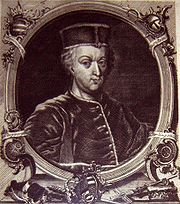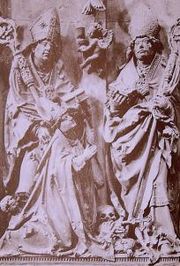
Uriel von Gemmingen
Encyclopedia


Maximilian I, Holy Roman Emperor
Maximilian I , the son of Frederick III, Holy Roman Emperor and Eleanor of Portugal, was King of the Romans from 1486 and Holy Roman Emperor from 1493 until his death, though he was never in fact crowned by the Pope, the journey to Rome always being too risky...
on 23 April 1509.
Uriel was one of ten children of Hans von Gemmingen (1431–1487).
In 1510, he was entangled in the Pfefferkorn controversy, after Johannes Pfefferkorn
Johannes Pfefferkorn
Johannes Pfefferkorn was a Jewish-born, German Catholic theologian and writer who converted from Judaism. Pfefferkorn actively preached against the Jews and attempted to destroy copies of the Talmud, and engaged in a long running pamphleteering battle with Johann Reuchlin.-Early life:Born a Jew,...
seized and desired to burn Jewish books. Gemmingen and the consultant Johannes Reuchlin assigned by him did not see a danger to the Christian faith in the writings used by Jews. On 10 May 1513 he appointed the Jewish physician Beyfuss the rabbi over all Jews in the Mainzer state. The argument over the book went beyond Uriels death in 1514, not ultimately settled until 1520.
He is supposed to have killed a cellar master
Wine cellar
A wine cellar is a storage room for wine in bottles or barrels, or more rarely in carboys, amphorae or plastic containers. In an active wine cellar, important factors such as temperature and humidity are maintained by a climate control system. In contrast, passive wine cellars are not...
in anger shortly before his own reputed death after catching the man stealing wine. Rumors suggested that he may have then faked his own death, and that the body buried in Mainz Cathedral
Mainz Cathedral
Mainz Cathedral or St. Martin's Cathedral is located near the historical center and pedestrianized market square of the city of Mainz, Germany...
was instead that of the cellar master, with Uriel afterwards fleeing to Italy where he died years later. However the tomb was reopened in 1724, where a corpse was found with the expected adornments of an archbishop; the matter is still considered unsettled.

